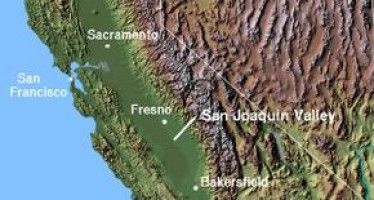CA Dems Push Sham River ‘Consensus’
By WAYNE LUSVARDI
The waters are being roiled again in the Delta.
The roiling concerns H.R. 1837, the Republican-backed San Joaquin River Reliability Act currently pending before the U.S. House of Representatives.
Northern California Rep. John Garamendi, D-Walnut Grove, says the bill “destroys a state consensus” on the San Joaquin River and the Sacramento Delta. Nothing could be further from the truth.
California’s Democratic U.S. senators, Barbara Boxer and Dianne Feinstein, have joined Garamendi’s chorus and called “for consensus-based solutions that respect the interests of all stakeholders.”
There never was a consensus except perhaps between the plunderers of the spoils from California’s perpetual water wars.
The Shame of the River Consensus Sham
Garamendi says H.R. 1837 would undo 150 years of water law, remove all environmental protections for the Delta and Central Valley farmers and allow destructive water exports from the Delta.
He says H.R. 1837 should be called the “State Water Rights Repeal Act.” He’s right — but for the wrong reasons. What H.R. 1837 does is undo what Feinstein did with the San Joaquin River Restoration Act of 2009 – H.R. 146. That bill was enacted three years ago, not 150 years ago.
Contra Garamendi, H.R. 146 was a prior water grab from farmers. It limited how much water farmers can take for crop irrigation and imposed tiered water rates and environmental impact reports for renewal of all existing water contracts. In short, Feinstein’s H.R. 146 redistributed the water taken from farmers to fishing, recreational and real estate interests.
There was no bipartisan consensus when Feinstein’s bill was passed. In fact, it had to be bundled with a bunch of bills under the Omnibus Public Land Management Act of 2009 for it to pass even through a Democratic-controlled Congress and get signed by Democratic President Barack Obama. There was no “consensus” except of Democrats. Consensus implies that those having to give up water rights and have to pay higher water rates somehow concurred with Feinstein’s bill. This was not the case.
H.R. 1837 Would Restore Genuine Consensus
What Republican Rep. Devin Nunes’ HR 1837 bill would do is repeal Feinstein’s HR 146 and replace it with the Bay-Delta Accord drafted in 1994. The Bay-Delta Accord was “consented” to by both then-President Bill Clinton, a Democrat, and then-California Governor Pete Wilson, a Republican. This is what genuine “consent of the governed” entails.
Rep. Nunes’s HR 1837 would depoliticize water contracts. H.R. 1837 provides for water contracts to be renewed automatically, instead of being thrown to political piranhas for the picking under a contrived retroactive environmental impact report.
Sure, by undoing H.R. 146 and replacing it with H.R. 1837 commercial salmon fishermen, sport fishing and recreational-real estate interests would be denied new water rights. But they never had any water rights in the first place. Nor were there any environmental impacts on them because they had no rights or ecosystem to impact. All that an environmental impact report would conclude under California’s sham California Environmental Quality Act is that salmon fishing rights were not granted 150 years ago and should be now.
But farmers had to buy their land to get their riparian (river) water rights 150 years ago. A riparian right is a right to use the natural flow of water on land that touches a river, lake, stream or creek.
Appropriative water rights are those obtained by permit, court actions or legislative action. Such rights are always subject to who is in political power and whom they may want to redistribute the rights to.
Garamendi also claims that H.R. 1837 is “imbalanced” and does not “satisfy the needs of everyone in California.” HR 1837 is no more imbalanced than is Feinstein’s H.R. 146, which harms Central Valley farmers.
Neither would H.R. 1837 “take away California’s ability to control our own water destiny,” as Garamendi claims, any more than Feinstein’s H.R. 146 did. Both H.R. 146 and H.R. 1837 are federal legislation.
As for the charge that “water storage and water recycling are important components of water policy, and they’re lacking in HR 1837” — the same could be said of H.R. 146.
H.R. 1837 also does not, as the Democrats claim, “threaten thousands of jobs for salmon fishermen and Delta farmers.” Those thousands of jobs for San Joaquin River salmon fishermen and farmers would just be taken away from Central Valley farmers and from city water ratepayers and consumers of agricultural produce.
Politics is Dis-sensus
Any determination of an environmental impact under H.R. 146 isn’t environmental, but cultural and political. Why, under Feinstein’s HR 146, in a drought should commercial salmon fisheries, sport fishermen and recreational/real estate interests have first dibs on water over? Why should fishing and recreational interests be granted water rights without buying them?
And what about the “stranded assets” of farmland that no longer will have irrigation water? Shouldn’t government re-pay farmers for those “sunk costs,” instead of hiding behind the sham that a “regulatory taking” is non-compensable? Where is the “public purpose” behind the sham wealth redistribution of H.R. 146? How is H.R. 146 any different than taking private property rights and giving them to developers under California’s defunct Redevelopment Law?
Water Rights by Force and Fraud — or Consent of the Governed?
A mix of force, fraud and consent of the governed have held California’s historic water contract together. The elements of that contract have been Northern California giving up water to Central Valley farmers and Southern California cities in exchange for Delta flood protection, cheap hydropower and some water for themselves.
Feinstein’s H.R. 146 and the state-level Delta Reform Act together change the existing water social contract in California so that Central Valley farmers and Southern California cities get less water and in return Northern California gets Delta flood protection, cheap hydropower, a greater share of the water to redistribute to special interests and a new Delta regional sewage system to be paid for mainly by farmers and cities in the Southern half of the state.
Feinstein’s H.R. 146 confiscated water rights by the force of law and the fraudulent ideology of environmentalism and redistributed it to non-farming constituents under a wealth distribution scheme. Nunes’ H.R. 1837 merely returns those water rights to the pre-2009 genuine political “consensus.”
A sham consensus is no substitute for consent of the governed in California’s political water wars.
Related Articles
California’s disappearing farmland
More than 370,000 acres of California’s irrigated farmland disappeared from 2006-10. Officials are concerned that hundreds of thousands of
Root Canal For Single-Payer Health Bill
JAN. 26, 2012 By KATY GRIMES Despite warnings that tooth decay in children can lead to a life in prison,
Cadiz blending pipeline cuts salt in water
California farmers harvest more than 1.7 billion strawberries every year. Reducing the salt content in irrigation water is critical to





